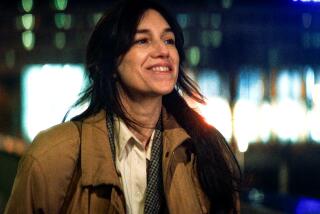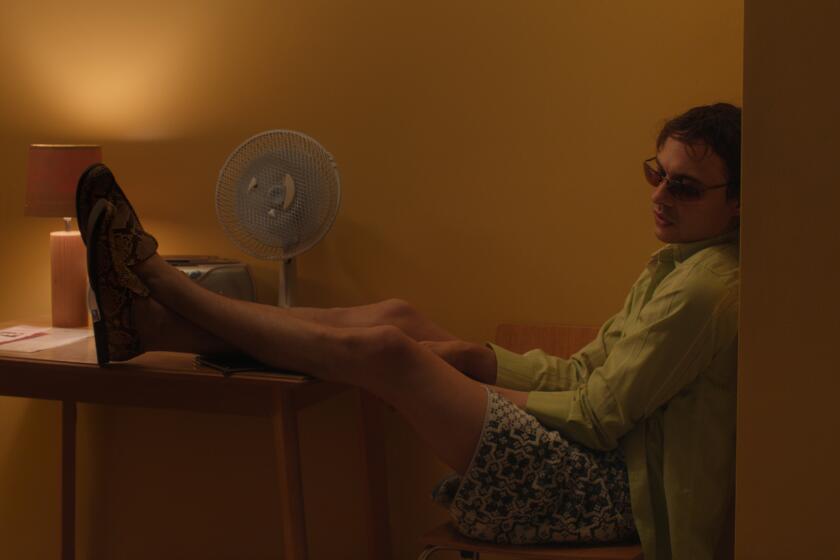Chantal Akerman’s body of work, moment by moment
- Share via
Chantal Akerman’s great subject is dislocation: the difficulty of fitting in, of feeling at home, of being. It’s a theme this remarkable filmmaker -- born in Belgium but a professional nomad much of her life -- explored with focus and ferocity in the first decade of her career. That period is the subject of “Chantal Akerman in the Seventies” ($44.95), a new three-disc set from Criterion’s budget line Eclipse due out this week.
Like Orson Welles, Akerman made her first masterpiece, “Jeanne Dielman, 23 Quai du Commerce, 1080 Bruxelles” (1975), at age 25. An improbably suspenseful three-hour-plus drama about a housewife’s daily life, it was hailed as a landmark and still looms large over her career. But Akerman’s lesser-known ‘70s films are of a piece with the seminal “Jeanne Dielman”: sensual and severe in equal measure, notable both for their formal rigor and their emotional intensity.
After dropping out of film school, Akerman lived in New York for a spell in the early ‘70s and found inspiration in the city’s avant-garde scene. The Eclipse set includes two silent shorts made during that stay, both shot by Babette Mangolte, who also shot “Jeanne Dielman”; both represent important evolutionary steps for a filmmaker working out a cinematic language based on repetition and real time.
In the 11-minute “La Chambre” (1972), a camera pans 360 degrees around a small apartment. Each cycle shows us the objects in the cramped space -- a chair, a bowl of fruit, dishes in a kitchen sink, etc. -- and Akerman in bed. Each time the camera lands on her, the filmmaker does something different: looks straight at the lens, tosses in the sheets, fondles an apple. Eventually the camera breaks out of its trance, abruptly reversing course midrotation.
The hourlong “Hotel Monterey” (1972), which suggests a succession of Edward Hopper paintings come to life, moves through a ramshackle Manhattan hotel, lingering on the empty spaces and picking up the occasional solitary figure.
Akerman has explored self-portraiture (and self-exposure) from the start. In her feature “Je, tu, il, elle” (“I, You, He, She”), she plays the neurotic Julie who spends the first third of the film confined to a spartan apartment, engaged in compulsive behavior. She repaints the walls and rearranges the furniture, writes and rewrites a letter, scoops spoonfuls of sugar into her mouth.
The rest of the film depicts two encounters that Julie has after leaving her home: first with a trucker who gives her a ride and accepts her sexual services before delivering a long monologue about his family life, then with an ex-girlfriend who succumbs to an erotic reconciliation.
“Les Rendezvous d’Anna” (1978), a sequel of sorts to “Je, tu, il, elle,” likewise follows an unmoored heroine on an open-ended journey. A Belgian filmmaker on a promotional tour, Anna (Aurore Clement) makes her way through a series of indistinguishable railway stations and hotels.
There are fleeting connections with a few men -- a one-night stand, a stranger on a train -- but the most intimate moment has her lying in bed with her mother, recounting a lesbian affair.
The mother-daughter bond features prominently in Akerman’s early work. She has said that “Jeanne Dielman” draws on memories of her mother’s domestic routines. “News From Home” (1977), the high point of the Eclipse set, combines precisely framed Manhattan streetscapes with off-screen recitations of letters that Akerman’s mother wrote to her during her earlier stay there.
As this one-way conversation unfolds, sometimes muffled by the sounds of the city, we see Travis Bickle-era New York in its grubby glory: deserted side streets, busy intersections, crowded subway cars whose passengers occasionally direct inquisitive gazes at the camera.
In the final shot, a 10-minute take from a departing ferry, it pulls away to reveal a fog-shrouded Manhattan skyline that includes the World Trade Center.
One of the all-time great New York movies, “News From Home” is a city symphony that doubles as a portrait of exile, a film with a powerful sense of place and of displacement.
More to Read
The biggest entertainment stories
Get our big stories about Hollywood, film, television, music, arts, culture and more right in your inbox as soon as they publish.
You may occasionally receive promotional content from the Los Angeles Times.










